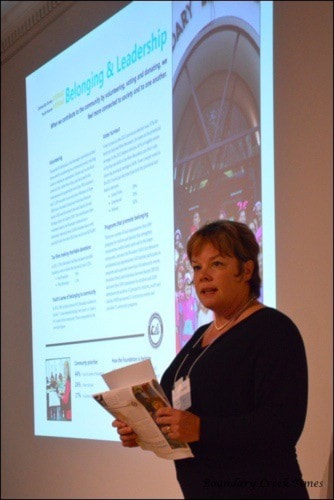We need to create local employment opportunities that support a living wage— too many people have to go outside the area for work, and many of the jobs that exist locally are minimum wage and not sufficient to meet basic needs.” – citizen feedback reported in the Boundary Communities Vital Signs 2014 report.
~~~~~
A year in the making, the 2014 Vital Signs report on the Boundary was released a week ago Tuesday, Oct. 7 at gallery 2 in Grand Forks.
Vital Signs is a community check-up that measures the vitality of the communities, identifies significant trends, and supports action on issues that are critical to quality of life.
The release date was timed to coincide with the launch of 25 other community reports across the country as part of the Vital Signs Canada (www. vitalsignscanada.ca/) program. This is the second report done on the Boundary region; the first was done in 2009.
Christina Thompson, chair of the Phoenix Foundation of the Boundary Communities, welcomed approximately 50 guests to the launch and introduced the 11 members of the steering committee responsible for the update over the past year.
The project manager was Karly Olsen.
During that year there was community consultation through town hall meetings and youth forums. This helped inform the creation of a survey that went out in August in which citizens were asked to rate each of 11 issue areas on a five-point scale and to identify their top three priorities. There were 330 surveys completed; up about 100 from the 2009 survey.
One of the main uses of the report is to inform the grants committee of the Phoenix Foundation of the Boundary Communities. According to committee chair George Longden, the local foundation distributed about $45,000 in 2014, and has been able to grant $$387,722 in the 17 years that the foundation has been around.
“This year we actually left money on the table because we didn’t have enough people apply for grants that were directed to specific endowments,” Longden said. “So we are looking for grant applications in all 11 of the areas of Vital Signs.”
He announced a grant-writing workshop that will be held in the second or third week of January. It is hoped that this will result in quality grant applications that fit within the areas identified in the Vital Signs report.
Doug Lacey, who is the vice-president of the foundation board, explained that a day-long workshop a year ago helped shape the vision of where they wanted the foundation to be by 2018. A new strategic plan was developed, which included an update of the 2009 report. Another major piece of the new strategic plan is the goal of growing their investment fund to $1.8 million.
Olsen said the updated plan cost in the neighbourhood of $31,000; with $10,000 of that from a Newman’s Own Foundation grant sponsored by Grand Forks Buy-Low Foods. The City of Grand Forks sponsored a Healthy Communities grant application that brought in another $5,000. The Phoenix Foundation kicked in another $10,000 and the balance came from other local sources.
In May 2014, 83 youth aged 15-18 years, participated in Vital Signs youth forums in the East and West Boundary. They rated the 11 issue areas on a five-point scale and identified strengths and areas of improvement. Work, transportation, arts and culture and learning all received ratings of poor by the youth forums.
Of the eleven issue areas work was rated as the first priority by the citizens. The report suggested that one of the best ways to help the local employment situation is to buy local.
“At the most basic level when you shop local, money stays in the community,” said the report. “This helps create more jobs, reduces environmental impact and invests in the community.”
The community’s second priority is health and wellness, with anxiety and depression identified by 30 per cent of survey respondents as their top priority for further improving health and wellness in the Boundary. That was closely followed by the number of physicians per capita (28 per cent).
The third citizen priority is the gap between rich and poor. According to the report, 33 per cent of residents in the West Boundary live in low-income households.
The other eight key issues areas covered by the report are Arts and Culture, Housing, Transportation, Learning, Belonging and Leadership, Environment, Safety and Food Security.
Olsen explained, “The last report was used by the Phoenix Foundation to direct their grants, and by various community agencies like the Boundary Family and Individual Services Society and the school district to make decisions about programming.
“We don’t view the report as the end,” Olsen said in an interview after the launch. “This is the beginning of spurring citizens into action and convening around these issues. That’s really where we are going in the next five years.”
More can be found online at www.phoenix-foundation.net.
